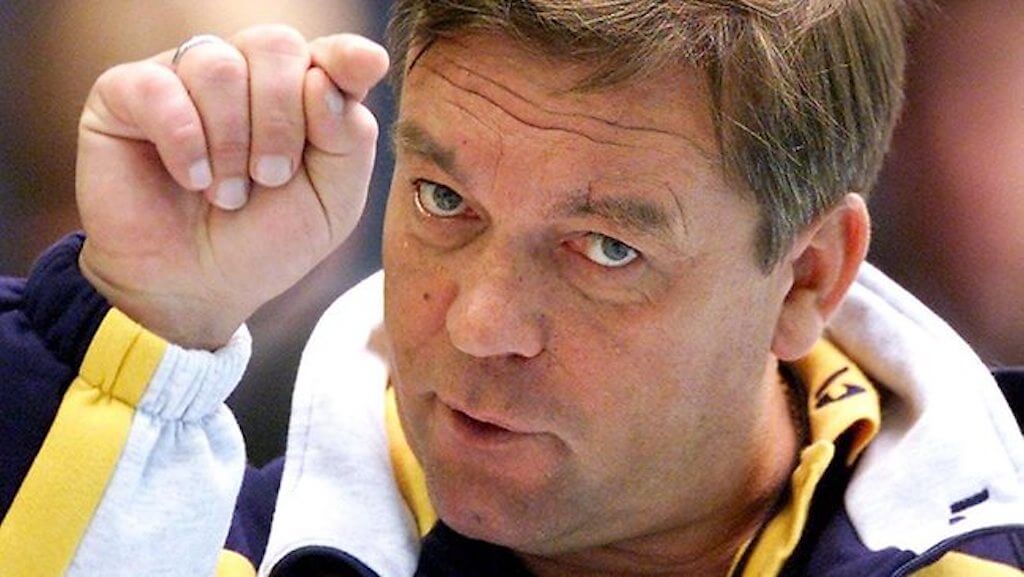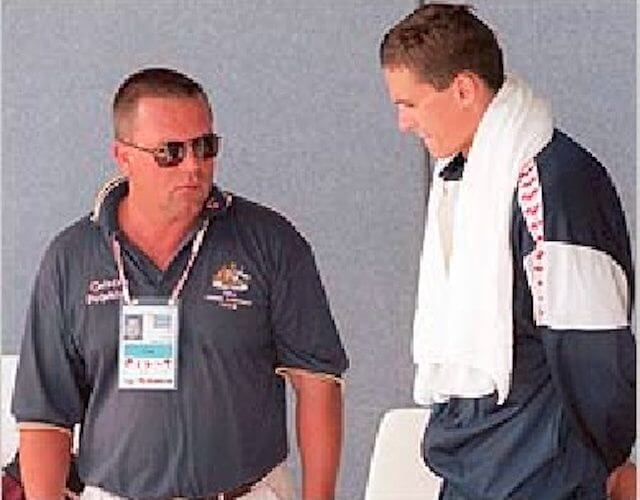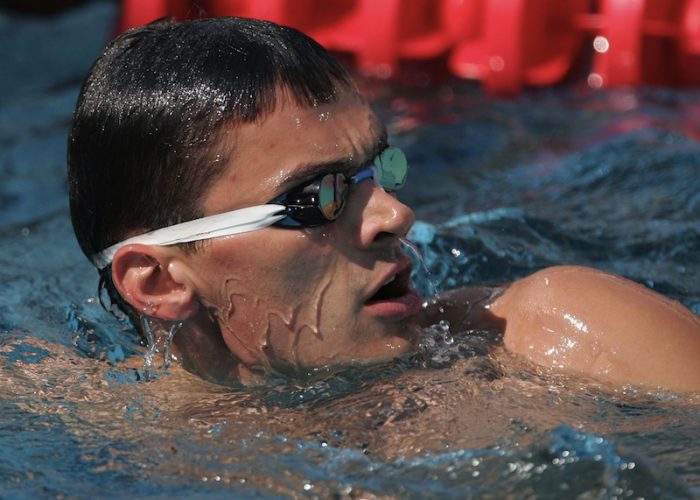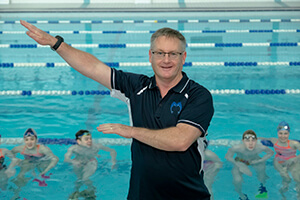Gennadi Touretski – Recollections Of A Swimming Genius During His Days Down Under

Gennadi Touretski passed away earlier this month, Swimming World’s obituary accompanied by tributes, including one from swimmers who worked with him, at the helm Alexander Popov. Here, Wayne Goldsmith reflects on Touretski’s time Down Under and the legacy he left world swimming.
Commentary: This commentary is intended to give honour and respect to an outstanding swimming coach and in my view a true swimming genius – Gennadi Touretski. I have written it from the perspective of my own direct experiences with Gennadi and have not commented on his many achievements before 1993 or his life after our last direct contact. I would not pretend to know him well but the time I did spend with him was rewarding and inspiring. There are a lot of “myths” about his coaching, particularly surrounding his work with the great Alex Popov so I have concentrated on only what I saw in person with my own eyes and on the discussions I had with him over an extended period of time. The focus of this paper is very much on his philosophies, his influence on the sport and his unique approach to coaching the sport of swimming. (NB: “NB xzxzxz – Ed” notes are penned by Swimming World Editor Craig Lord)
Gennadi Touretski Background – Why Recruit a Russian?
In 1992, Don Talbot, the head coach of Australian Swimming, had, by his own high standards, a poor Olympics.
In private discussions, in meetings with Australia’s high performance swimming coaching community and even in the media, Talbot admitted to asking himself some hard questions about the nation’s approach to coaching swimmers capable of winning Olympic medals.
In one telling interview, Talbot reported publicly that for Australia to return to it’s position as a leading swimming nation and a reasserting it’s heritage as a dominant force at international level, it would be necessary for us to improve our capability in the area of sprinting.
Talbot said publicly that the nation needed to learn how other countries were coaching speed and that as most competitive swimming events at the Olympic Games and World Championships were 200 metres in length or less, our future success as a swimming nation would be dependent on us learning how to coach world-class sprinters.
Not long after, Talbot announced that in a major coup, he’d recruited the Russian coach of the Barcelona Olympic 50- and 100-metre champion Alex Popov: Gennadi Touretski.
First Impressions
My first experience with Gennadi was over a coffee at a small café near the Australian Institute of Sport (AIS) in Canberra. His English was apparently limited and he seemed tired, bored and uninterested in the discussions. He would occasionally offer up an idea or an anecdote to the conversation with the help of an interpreter but he appeared to be naturally shy, guarded and perhaps even a little suspicious.
On reflection after the meeting when I was asked, “What did you think of Gennadi Touretski?”, I remember thinking and saying, “Not much. He might find it difficult here.”
I was wrong.
The Moment That Changed Everything

Gennadi Touretski and Alex Popov
The Australian Institute of Sport (A.I.S.) in the 1990s was a national focal point for coach education, training and development. It was common for sporting organizations to conduct national coach education conferences, workshops and seminars at the AIS and it was at one such coach education event in 1993 that Gennadi challenged – and to those who were listening with an open mind – changed the course of sprint swimming in Australia.
With all the customary subtlety of a sledgehammer and through the use of a translator – (to this day I can’t figure out how the person hired made it out of that room alive), Gennadi said (quotes taken directly from my contemporary notes of that meeting):
“I have long respected the swimmers and coaches of Australia and we (Russia) have studied your coaching methods in detail. However, I do not understand why you do so much training at threshold pace. It does not make sense to spend weeks and months training at such high intensities and not seeming to focus on the development of speed until late in your training cycle.”
There were some murmurs and seat shifting in the audience.
That was just the warm-up! This from Gennadi Touretski went down like a bomb:
“Speed is the most precious thing in swimming. It is what it is all about. I do not understand why you would spend weeks and months not training speed, then hoping it will come back when you taper and race. I believe you must always be within one second of your personal best time at all times of the year. That you must train for speed all year round. That your sprinters must sprint often and race regularly throughout the year.”
Now, you need to understand the context of that comment.
The Australian “method” for more than 30 years had always been to work hard developing an aerobic base for 10, 12, 16 weeks or even longer, then to significantly reduce training volume close to the competition.
This philosophy had grown from the work of Forbes Carlile’s “Speed Through Endurance” approach which had in turn been the basis for the coaching success of some of the nation’s greatest coaches, including Bill Sweetenham, Laurie Lawrence, Joe King, Ken Wood and even Don Talbot himself.
Australian coaches were known for their commitment and dedication to hard work and Australia’s international success in the 70s, 80s and 90s came from coaching programs which for the most part subscribed to the high work-ethic philosophy.
Now here was some Russian coach who could barely speak English standing there saying basically “You’ve got it wrong” to a room full of Australian coaches who believed in an ostensibly opposite coaching philosophy (NB – and had enjoyed a lot of combined success on the basis of their approach, while Touretski was talking at a time when Popov was his one big success – Ed).
I remember sitting there feeling stunned, amazed and inspired. Who was this guy?
Re-Thinking the Coaching of Speed in Swimming
Forbes Carlile was a giant in the sport of swimming: a man of incredible intellect and insight and an individual whose influence on the sport here in Australia and around the world was – and still is considerable.
One of Forbes’ landmark works was his “Speed Through Endurance” philosophy which was in short:
- To swim fast, the swimmer must be efficient (i.e. physiologically and biomechanically);
- To be efficient, you need to repeat things many times;
- Therefore, the more you swim, the more efficient you become (i.e. as in physiological and biomechanical efficiency) and …
- The faster you can swim!
This Speed through Endurance philosophy was at the very heart of swimming coaching planning and periodization in Australia for half a century such was the influence of Carlile.
However, coaches from other nations not in Carlile’s considerable intellectual shadow, had come to see speed and speed development from a broad range of different perspectives.
Gennadi was one such coach.
I could talk about Gennadi and speed at length but here are some of his most important principles:
- Speed is the most important thing in swimming. It’s what we train for. Everything is about speed;
- Tension is the enemy of speed;
- The faster you want to go – the more relaxed you need to be. Swimmers must learn to remain relaxed as speed increases – Relaxation and Speed are directly connected;
- Do not assume speed will return once it is lost. For that reason, include speed training throughout the year – at all times of the training program.
Carlile was an outstanding coach, thinker and philosopher. Gennadi was – in his own way – a genius.
I was fortunate to know them both and to have had the opportunity to spend many hours discussing swimming philosophies with each of these remarkable swimming gurus.
For the coaches who were aware of the opportunity and took the chance to combine the traditional Australian “Carlile” approach with the injection of Touretski’s unique creative speed development and periodization principles, success usually followed.
Walking with Alex Popov and Gennadi Touretski
On several occasions I had the opportunity to walk up and down pool decks with Gennadi while he was coaching Alex Popov and I count these sessions as some of my most important and special moments in the sport – EVEN THOUGH most of the time all I did was walk and watch.
Every so often Gennadi would say something to me – in a mixture of Russian and English. He’d tell me “this is the most important thing” – (which he would say about almost everything) – but for the most part, it was walking and watching the great man in action doing what he did best.
There were moments of solid gold.
The Thing With Drills…
On one occasion, we were walking up and down the deck in Canberra while he was coaching Popov and he said to me:
“I think coaches do too many drills. Drills do not improve technique. They teach the basic movements of the stroke. To improve technique you must work with the individual swimmer, over a range of speeds, from slow to race speed and give them constant feedback about their technique, talk to them about how it feels and help them to develop their own technique. Every swimmer is different – every technique is different”.
In what Gennadi Touretski would call a “technique session”, he would walk with the swimmer continuously throughout the session, ask them to swim initially at a slow speed, then have them progressively increase speed until he would notice a technique inefficiency. He would then ask the swimmer to stop, discuss what was happening with them and then re-commence the slow to fast stroke-development process.
At the time – and even to this day – I see a lot of swimmers and triathletes all doing what they call “Popov” drills, a series of stroke development drills popularized by a video Gennadi released in the mid 1990s outlining the training of Alex Popov.
The funny thing was … I never personally actually saw Popov doing Popov drills outside of clinics and demonstrations – but I did observe him and Gennadi work on technique constantly.
The COLD SWIM – A Game Changer
As Gennadi had mentioned not long after his arrival in Australia, the traditional Australian training model was – more or less:
- Large volumes of non-specific “aerobic base” development training;
- Two – Three high intensity, “threshold” type, “heart-rate” sets each week;
- Sprinting and race speed development training relatively close to the targeted competition;
- Taper, rest, race.
- Recover – and repeat the above.
It was uncommon to see Australian swimmers asked to race at – and more importantly – be required to achieve – personal best sprint times during training periods, where the focus was on heavy aerobic training loads.

Alexander Popov – Photo Courtesy: Patrick B. Kraemer
One early morning in Canberra in 1993, I was attending training at the A.I.S. and observed what I describe as the “GAME-CHANGER” for my own thoughts about the sport.
Gennadi arrived on deck and spoke briefly with several swimmers, then spent a few minutes in private conversation with Alex Popov.
Popov spent perhaps four or five minutes moving, stretching, loosening, swinging his arms and then – he lined up on the blocks and sprinted 50!
At the time the world record for 50 metres freestyle was 21.81.
Popov swam 22.something for the 50 metres – timed by a stop watch sitting quietly in my jacket pocket.
Now think about that for a moment.
He was unshaved, unrested; he was not wearing top quality swim suit or goggles as he would in competition (NB: his career was, in fact, marked by the wearing of textile briefs for all his major swims – ED).
He wasn’t even wearing a cap (NB: he never did – ED).
He didn’t do a pool warm up.
Yet, he swam a time in training, early in the morning, with limited notice and without doing a warm up that would have won many of the world’s senior men’s freestyle 50 metre events that year.
I remember driving away from the pool thinking and pondering over what I’d seen that day.
Over the coming years I spoke with Gennadi about the role of cold swims, on being able to race at or close to personal best speed whenever and wherever required – and on his philosophies on speed development generally. On every occasion I learnt something new, challenging and ground-breaking.
One of the great Touretski-Popov “Myths”
As I’ve travelled delivering coach education clinics around the world over the past 25 years, I’ve heard a lot of Touretski – Popov Myths. I’d like to “bust” one of them that’s mentioned frequently:
- MYTH: Train speed – and nothing else.
- BUSTED: During a three week pre-Olympic camp in 1996, I observed in person, Popov, Michael Klim and other swimmers in the Touretski squad complete an average of over 85 kilometres of training PER WEEK with a peak distance of 91 kilometres for ONE WEEK. The vast majority of the training was very slow, with great technique and skills and with an emphasis on relaxation and stroke efficiency but contrary to popular belief, they did train for endurance, threshold, MVO2 and aerobic capacity. I’ve spoken with swimmers, coaches and sports science staff who report similar observations, (NB – observations that were reported by mainstream media in interviews with Touretski, too – ed).
In short, Gennadi and his team WORKED hard! I’ve heard people speak with “authority” that they only trained speed, that they rarely exceeded 30 kms per week in training but this is incorrect.
Lesson – don’t believe everything you hear! (NB – and do believe at least some of what you read in the mainstream media – because it’s true! – Ed)
Six Incredible Touretski Training Techniques and Coaching Systems
(That Are Just As Relevant Now).
I have a large catalogue of Gennadi innovations which demonstrate the extent of his genius and creativity. Here are just six:
- FLEXIBLE TRAINING CYCLES
Of all the discussions I had with Gennadi, the issue of what I’ve termed “anti-periodization” is one of the most memorable. Most swimming coaching and sports coaching generally is based on cycles of training which are typically built around the working week, i.e. a one week microcycle, a four week macrocycle. Gennadi argued that the training cycle is NOT about the calendar – it’s about the athlete and how the athlete adapts to training loads. It is – using his word – “impossible” that every athlete in your program will adapt to their training load at 6 am on Monday morning! His training cycles were flexible, adaptable and athlete focused and not limited by the day, the date or the calendar.
Sometimes he would schedule two “microcycles” in a seven day week. On other occasions he would designate a number of training sessions as a “microcycle”, e.g. 23 sessions and the microcycle went as long as it took the swimmers to complete the 23 sessions to the required standard.
At a time where Tudor Bompa’s text “The Theory and Methodology of Training” was widely accepted as the “bible” of training planning and periodization, Touretski challenged – and even ripped apart the assumptions and norms that most of the swimming coaching world was following.
- FITNESS UNITS
Gennadi was looking for some ideas to help his team progressively and flexibly develop a high level of athletic fitness outside the pool. One idea he implemented was that of FITNESS UNITS. Although there are countless variations of this technique, here’s a typical example:
- Week 1: 200 fitness units per day. Exercises: Push ups, chin ups, dips, step ups, body weight squats, burpees. Must do at least 20 units (repeats) of each exercise. No more than 50 of any one exercise.
- Week 2: 300 fitness units per day. No more than 75 of any one exercise.
- Week 3: 400 fitness units per day. Etc. No more than 100 of any one exercise.
One of the key principles behind this approach was to empower the athlete to choose when and how to achieve the number of “units” per day and to re-think the role of dry-land training from something that you went to and completed in a gym, to incorporating strength and conditioning training into your daily life.
- NATURAL TRAINING
One morning Gennadi Touretski said that he believed the training environment of swimmers – particularly in cold climates, i.e. indoor pool, stuffy air etc was “unnatural” and not ideal for optimal physical or mental health.
At the time, Dr David Pyne and I would regularly walk in the mountains near the A.I.S. in Canberra and on several occasions Gennadi would accompany us – along with some athletes – who would not only complete the hike but would complete their “fitness units” (see above) outdoors in a beautiful, natural setting. The concept is to shift swimmers from being merely “athletes” who can swim up and down a black line to embracing a holistic 24 hour a day athletic lifestyle.
- THE PERIODIZATION OF NUTRITION

Fuel For The Immune System – Photo Courtesy: Craig Lord
This one was a mind blower. In 1994, Gennadi was talking about the use of supplements.
He said (again taken directly from my notes of the time), “Everything must be linked and connected to the training program cycle – even diet and supplement use”. The use of supplements must be he said – wait for it – “PERIODIZED – to maximize their impact and role in maintaining the athlete’s health, well-being and performance”.
“Just taking the same supplements the same way all the time is a waste. Once the coach and athlete have finalized the training program, then the nutritionist must support the stress / load / adaptation cycle with a periodized approach to nutrition and supplementation”.
This concept was quite revolutionary and I do not believe is still completely understood or utilized by coaches or athletes around the world.
- RELAXATION IS ALL IMPORTANT
Gennadi Touretski talked a lot about technique but one specific aspect of technique was remarkable in its simplicity and effectiveness.
He was talked to a group of coaches about the concept of distance per stroke. He said this – “Distance per stroke – I call “range”. Range comes from relaxation and relaxation comes from rhythm. As a swimmer learns to swim with rhythm, their body will relax in the water. Once they’ve learnt how to relax in the water they can move more easily and efficiently and their range of stroke will increase”.
Simple but brilliantly effective: RHYTHM / RELAXATION / RANGE.
- DRYLAND TRAINING DIRECTLY CONNECTED TO RACING PERFORMANCE
One of Gennadi’s more innovative training activities was dryland training activities which were linked and connected to the achievement of a performance goal.
For example, every swimmer does some version of the “plank” core development exercise.
Gennadi Touretski developed a training activity where the swimmer’s competition goal time would determine the duration and format of a core stability exercise.
For example:
- Goal time: 53 seconds for 100 fly.
- Exercise: Using the “back-hyper-extension-bench” the swimmer raises their body to be parallel to the ground, with their core muscles – lower back, abs, scapula etc. all engaged. In that position, the swimmer moves their arms (using the specific stroke technique) at the target race rating and rhythm for 53 seconds while maintaining core stability and control – thereby incorporating an element of race visualization and imagery techniques into the dryland training activity.
After rest, the athlete would complete the “connected-core” exercise.
The above list, while not exhaustive provides some insights into Gennadi’s unique ability to apply creative and lateral thinking to known and accepted coaching practices and training philosophies.
The Last Time …
The last time I had the opportunity to meet with Gennadi Touretski in person was some time ago. I wanted to find a way to say thank you and to tell him how much I’d learnt from him.
I remembered a discussion we’d had one night over a few drinks while listening to some blues guitar music. He asked me if I’d heard of a great Australian athletics coach called Percy Cerutty – (pronounced “Cerity” – as in sin-cerity as Cerutty himself would often remark) – as Cerutty had been an influence on Gennadi’s own thinking.
I told Gennadi, that I too was a big fan of Cerutty – (coach of Olympic 1500 metre – track – champion Herb Elliot) and had all his books. We discussed Cerutty’s philosophies at length, including his belief in “natural” fitness, the essential need for hard work, the adoption of a natural diet, the importance of strength training, mental toughness and the importance of speed.
I gave Gennadi Touretski my 1960 original copy of Cerutty’s book “Athletics – How to Become a Champion” and told him it had been my honour to have the opportunity to learn from him.
Gennadi Touretski’s Legacy
It is impossible to measure in any meaningful way, the full legacy of Gennadi Touretski in swimming in Australia, Russia or around the globe.
Some will look at his time here with doubt, with negativity and with disdain believing the Australian way was – and still is – the only way.
Others will see and appreciate his influence as significant and substantial.
Many more will have been influenced by Gennadi and his work and not even know it.
I’ve been fortunate to work with and get to know a lot of great coaches.
Bill Sweetenham is brilliant. Eddie Reese is a coach and a man of wonderful skill, inspiring character and unbreakable values. Don Talbot was a leader of unparalleled skill. Carlile was beyond comparison as an innovator, thinker and fighter.
Gennadi was different.
He wasn’t perfect. The evidence, the stories, the tales are part of the news archive and the folklore of swimming.
But to me – he was a genius.
A man who was prepared to think differently and to think different things. A coach who adapted, evolved and grew with the situation, the challenge and his athletes.
A creative spirit who changed my thinking and I believe changed the sport of swimming around the world more than most people will ever realize. He has been a quiet influence on the sport.

Wayne Goldsmith
In Summary:
- I learnt a lot from Gennadi but here’s the five – as he would say “most important things”:
- Speed is EVERYTHING;
- Technique is a personal thing – it’s about optimizing the technical efficiency of the stroke of the individual swimmer. It’s not about just doing a lot of drills;
- Swimmers need the opportunity to develop athletic qualities and “natural” fitness outside of the pool environment;
- Dare to be different. Doing the same thing as everyone else is a doomed strategy and a flawed philosophy;
- Creativity comes in many shapes and innovation in many forms.
2. From a broader perspective, if something’s not working, take an honest look at what you’re doing and change it. If Talbot hadn’t been prepared to honestly and openly challenge the habits and traditions of swimming coaching in Australia at the time, things would not have changed (NB – and the results of 1998 through a World Championships in 2001 at which Australia won the meet over the United States on the gold standard, and beyond – reflected that – Ed). Whether you’re a coaching a Club, your State or the Nation, your ability to honestly reflect on your performance and your capacity to introduce and lead effective change are your most important attributes.
3. When someone stands in front of you and shares ideas that you don’t necessarily agree with … challenge the idea – don’t diminish the person. It would be fair to say that Gennadi did not always enjoy wide support from the Australian swimming community, primarily due to his uncompromising views and occasionally abrupt manner.
Many of his philosophies were initially outright rejected – but to those coaches who did listen and who did take time to learn, their coaching results in the last 20-25 years reflect in many ways just how much Gennadi had to offer.
RIP – Gennadi. Thank you for the opportunity to learn.
All commentaries are the opinion of the author(s) and do not necessarily reflect the views of Swimming World Magazine, the International Swimming Hall of Fame, nor its staff.




What a great, great read. Thank you Wayne, thank you Craig. RIP Gennadi, always a pleasure for me and my family to meet you and speak with you. Nick
Thank you Wayne for sharing your thoughts about someone who is not afraid to break the binds. A coach cannot expect faith and trial from an athlete if they themselves cannot demonstrate their own.
A week with Gennadi re-enforced the importance of speed work from the first week in practice to the taper. That’s why Accutraining test sets work in predicting performance times for a 50-100-200-500-1,650 with a high correlation. Watching Popov swim sets of 50’s with a perfect stroke holding 23’s forever.
RIP friend!
Thanks Wayne.